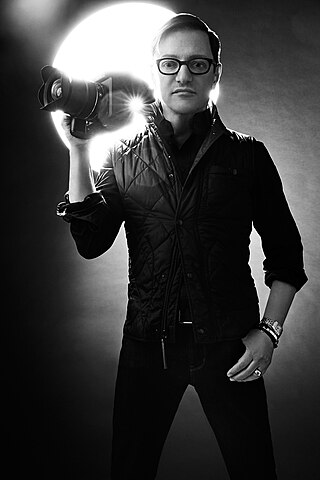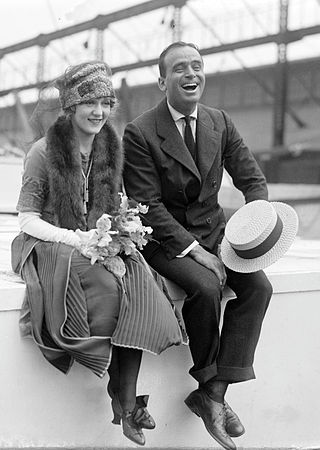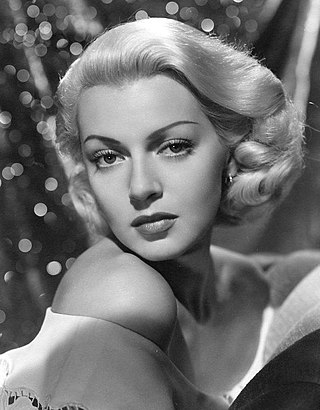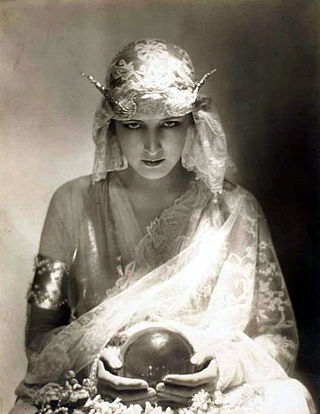
Costume or fashion jewelry includes a range of decorative items worn for personal adornment that are manufactured as less expensive ornamentation to complement a particular fashionable outfit or garment as opposed to "real" (fine) jewelry, which is more costly and which may be regarded primarily as collectibles, keepsakes, or investments. From the outset, costume jewelry — also known as fashion jewelry — paralleled the styles of its more precious fine counterparts.

A model is a person with a role either to display commercial products or to serve as an artist's model or to pose for photography.

Gothic fashion is a clothing style worn by members of the goth subculture. A dark, sometimes morbid, fashion and style of dress, typical gothic fashion includes black dyed hair and black clothes. Both male and female goths can wear dark eyeliner, dark nail polish and lipstick, and dramatic makeup. Styles are often borrowed from the Elizabethans and Victorians. BDSM imagery and paraphenalia are also common. Gothic fashion is sometimes confused with heavy metal fashion and emo fashion.

A brooch is a decorative jewellery item designed to be attached to garments, often to fasten them together. It is usually made of metal, often silver or gold or some other material. Brooches are frequently decorated with enamel or with gemstones and may be solely for ornament or serve a practical function as a clothes fastener. The earliest known brooches are from the Bronze Age. As fashions in brooches changed rather quickly, they are important chronological indicators. In archaeology, ancient European brooches are usually referred to by the Latin term fibula.
George Edward Hurrell was a photographer who contributed to the image of glamour presented by Hollywood during the 1930s and 1940s.
Glamour or Glamor most commonly refers to the presentation of enchantment, charm, excitement, and other appealing qualities exuding attractiveness.

Fashion photography is a genre of photography that portrays clothing and other fashion items. This sometimes includes haute couture garments. It typically consists of a fashion photographer taking pictures of a dressed model in a photographic studio or an outside setting. It originated from the clothing and fashion industries, and while some fashion photography has been elevated as art, it is still primarily used commercially for clothing, perfumes and beauty products.
Marcellas Reynolds is an American actor, author, documentarian, and television host. His notable television appearances include Access Hollywood, E! Live from the Red Carpet, The Bold and the Beautiful, Supreme Models, and Yes, Dear. Reynolds began his television career in 2002 on CBS's hit television series Big Brother season three, becoming the first openly gay black man cast on a major network reality series. His writing has appeared in Chicago magazine, Essence, The Guardian, and L.A. Style Magazine. Reynolds is the author of Supreme Models: Iconic Black Women Who Revolutionized Fashion and Supreme Actresses: Iconic Black Women Who Revolutionized Hollywood, Supreme Sirens: Iconic Black Women Who Revolutionized Music, and the executive producer of Supreme Models, the documentary.

Matthew Russell Rolston is an American artist, photographer, director and creative director, known for his lighting techniques and detailed approach to art direction and design. Rolston has been identified throughout his career with the revival and modern expression of Hollywood glamour.

Rachel Zoe Rosenzweig is an American fashion designer, businesswoman and author who rose to prominence as a celebrity wardrobe stylist. She has been credited with the creation of "the boho-meets-rock chic look that came to define a new breed of Hollywood ‘it’-girls who were as adept at setting trends as they were at causing trouble" in the mid-2000s. Describing her signature look to Vogue magazine, Zoe said: "It's very 60s to 70s glamour. It's Mod meets Grecian. A lot of gold and a lot of bronze, shimmer and glamour, but relaxed glamour, very unstructured, bold accessories." Zoe's clients as a stylist have included Cameron Diaz, Kate Hudson, Kate Beckinsale, Debra Messing, Demi Moore, Liv Tyler, Joy Bryant, Molly Sims, Beau Garett, Eva Mendes, Paula Patton, Anne Hathaway, Jennifer Lawrence, Miley Cyrus, and Pauly Shore.

Western fashion in the 1920s underwent a modernization. For women, fashion had continued to change away from the extravagant and restrictive styles of the Victorian and Edwardian periods, and towards looser clothing which revealed more of the arms and legs, that had begun at least a decade prior with the rising of hemlines to the ankle and the movement from the S-bend corset to the columnar silhouette of the 1910s. Men also began to wear less formal daily attire and athletic clothing or 'Sportswear' became a part of mainstream fashion for the first time.
Boudoir photography is a photographic style featuring intimate, sensual, romantic, and sometimes erotic images of its subjects in a photographic studio, bedroom or private dressing room environment, primarily intended for the private enjoyment of the subjects and their romantic partners. It is distinct from glamour and art nude photography in that it is usually more suggestive rather than explicit in its approach to nudity and sexuality, features subjects who do not regularly model, and produces images that are not intended to be seen by a wide audience, but rather to remain under the control of the subject.

Nude photography is the creation of any photograph which contains an image of a nude or semi-nude person, or an image suggestive of nudity. Nude photography is undertaken for a variety of purposes, including educational uses, commercial applications and artistic creations.
Louis Athol Shmith was an Australian studio portrait and fashion photographer and photography educator in his home city of Melbourne, Australia. He contributed to the promotion of international photography within Australia as much as to the fostering of Australian photography in the world scene.

Glamor photography is a genre of photography in which the subjects are portrayed in erotic poses ranging from fully clothed to nude. The term may be a euphemism for erotic photography. For glamour models, body shape and size are directly related to success. This type of photography is also known as "cheesecake" or "pin-up" for women and "beefcake" for men.

Italian design refers to all forms of design in Italy, including interior design, urban design, fashion design, and architectural design. Italy is recognized as a worldwide trendsetter and leader in design. The architect Luigi Caccia Dominioni claimed, "Quite simply, we are the best. We have more imagination, more culture, and are better mediators between the past and the future". Italy today still exerts a vast influence on urban design, industrial design, interior design, and fashion design worldwide.

Camille Chrystal Pourcheresse, known professionally as Camille Rowe, is a French-American model and actress.

Dolores or Rose Dolores was an English model. She is recognised as the first celebrity clothes model and has been credited with inventing the blank hauteur of the modern fashion model. Florenz Ziegfeld, Jr. called her "the loveliest showgirl in the world". She was known for her commanding stage presence and became the star of the Ziegfeld Follies from 1917 until her retirement in 1923. She lived the rest of her life in Paris and during the Second World War helped Allied airmen escape the German occupation.
Frederick John Watson was a Canadian fashion illustrator and painter from Barrie, Ontario. He is best known for his international paintings of women, fashion illustrations and theater and Art Deco posters. He has also created a fine art print collection of stylized women reminiscent of the Art Deco style. The start of inspiration for his work came from a woman he saw on Madison Avenue in New York City, wearing black, high heels, a diamond brooch, and carrying an umbrella.

American singer-songwriter Madonna has been considered a fashion and style icon by fashion journalism and other sectors. Fashion critics, designers and scholars have examined her influence in fashion from different stages, defining views on her public image and cultural significance. Her connection with the community was once labeled a symbiotic relationship, while her industry ventures include owning fashion brands and appearing at events such as the Met Gala.
















